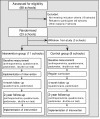Design and evaluation protocol of "FATaintPHAT", a computer-tailored intervention to prevent excessive weight gain in adolescents
- PMID: 17997834
- PMCID: PMC2206029
- DOI: 10.1186/1471-2458-7-324
Design and evaluation protocol of "FATaintPHAT", a computer-tailored intervention to prevent excessive weight gain in adolescents
Abstract
Background: Computer tailoring may be a promising technique for prevention of overweight in adolescents. However, very few well-developed, evidence-based computer-tailored interventions are available for this target group. We developed and evaluated a computer-tailored intervention for adolescents targeting energy balance-related behaviours: i.e. consumption of snacks, sugar-sweetened beverages, fruit, vegetables, and fibre, physical activity, and sedentary behaviours. This paper describes the planned development of a school-based computer-tailored intervention aimed at improving energy balance-related behaviours in order to prevent excessive weight gain in adolescents, and the protocol for evaluating this intervention.
Methods/design: Intervention development: Informed by the Precaution Adoption Process Model and the Theory of Planned Behaviour, the computer-tailored intervention provided feedback on personal behaviour and suggestions on how to modify it. The intervention (VETisnietVET translated as 'FATaintPHAT') has been developed for use in the first year of secondary school during eight lessons. Evaluation design: The intervention will be evaluated in a cluster-randomised trial including 20 schools with a 4-months and a 2-years follow-up. Outcome measures are BMI, waist circumference, energy balance-related behaviours, and potential determinants of these behaviours. Process measures are appreciation of and satisfaction with the program, exposure to the program's content, and implementation facilitators and barriers measured among students and teachers.
Discussion: This project resulted in a theory and evidence-based intervention that can be implemented in a school setting. A large-scale randomised controlled trial with a short and long-term follow-up will provide sound statements about the effectiveness of this computer-tailored intervention in adolescents.
Trial registration: ISRCTN15743786.
Figures
References
-
- Van den Hurk K, Van Dommelen P, De Wilde JA, Verkerk PH, Van Buuren S, Hirasing RA. Prevalentie van overgewicht en obesitas bij jeugdigen 4-15 jaar in de periode 2002-2004. TNO Kwaliteit van Leven; 2006.
Publication types
MeSH terms
Associated data
LinkOut - more resources
Full Text Sources
Medical



